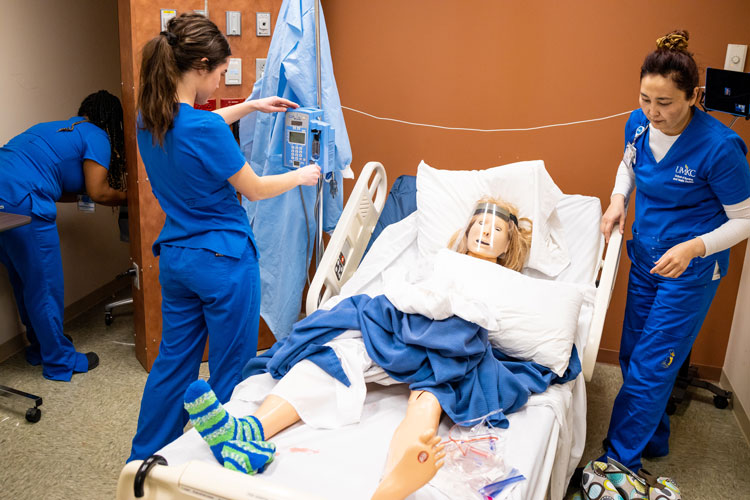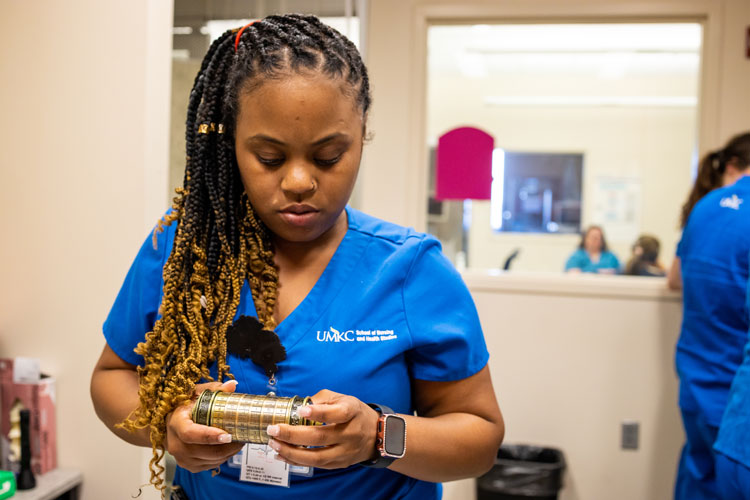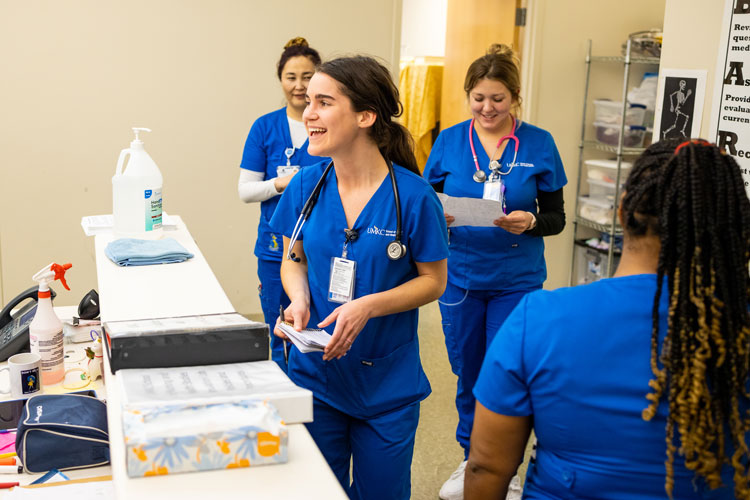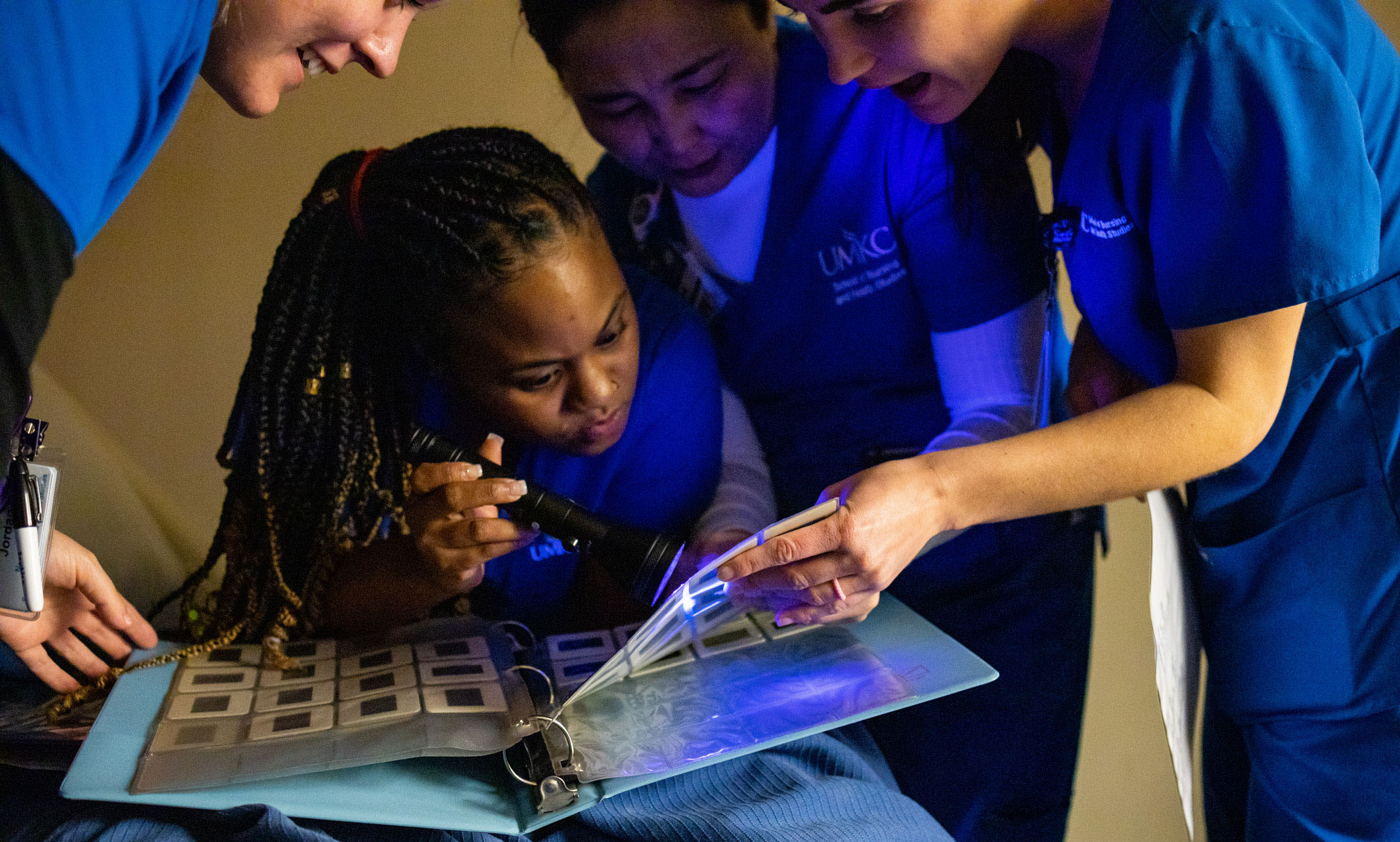For Christine Zimmerman, R.N., Ph.D., everything is a teachable moment for her nursing students, even escaping zombies. As director of clinical simulation at the UMKC School of Nursing and Health Studies, she designs and implements patient scenarios for the school’s simulation lab.
In the latest scenario, Zimmerman combined an escape room experience with a zombie apocalypse. Students solve puzzles and follow clues while competing for the best time to get the medical equipment they need to provide a blood transfusion to their “patient.” To complete the training and escape the room, the students need to complete each task of the procedure, which prevents their patient from becoming a zombie.
Over the years, Zimmerman and her team have created a wide variety of simulations for students, from helping a woman give birth to treating gunshot wounds. The simulations are designed to provide students the opportunity to practice their clinical skills and decision-making abilities in a managed environment that reduces some of the pressures involved in a traditional clinical setting. In the simulation lab, students can focus on the training at hand without the worry of keeping a patient alive or navigating interpersonal dynamics of coworkers.
The lab, on the fourth floor of the UMKC School of Nursing and Health Studies, mimics the layout of a hospital, with six patient rooms, a nurses’ station and a medication storage area. The school has nine manikins — models used for medical training that act as patients during the simulations. Zimmerman and her team operate the manikins from a nearby control room in the lab, speaking as the patient through a microphone during the simulation. They take their acting seriously, using different voices and incorporating sound effects.
According to School of Nursing and Health Studies Dean Joy Roberts, simulation is a critical experience for nursing students as they progress through the program.
“Typically, our undergraduate nursing students are given hands-on experience in hospitals and community health settings,” Roberts said. As an added layer to their training, the simulation lab “ensures that all of our students get experience with certain health issues, while ensuring the patient interaction is as close to real life as possible,” she added.
Zimmerman keeps up with the latest advances in nursing simulation education. She said research shows that a competitive gaming environment helps students learn by adding fun while lowering stress. A few years ago, she noticed a growing trend using escape rooms in simulation labs, and decided to try it. Setting it up was a daunting process, she said. She spent almost two years getting it right, and launched it the spring semester of 2023.
“We learned that getting the clues together was the hardest part,” Zimmerman said. “You have to think about how each clue builds to the next one, and how the students are going to progress through the steps to solve it.”

As in all simulations, students in the escape room exercise are into divided into groups of four. The groups then compete for the shortest time in finishing the required steps. Competition means the groups need team names picked by the students. “Public Enema” and “N’Syncope” are just two of the many clever team name selections.
For nursing student Joyce Young, who is in the final year of the program, the escape room required more teamwork than previous simulations in which she had participated. A former police officer, she was happy to bring her investigative abilities to the team.
“With the escape room, I had to really rely on my other team members, and we worked really well together,” Young said. “Everyone brought their own personality and skill sets, because one person’s strength was another person’s weakness.”
According to Zimmerman, she focused on blood transfusions because the procedure can be necessary in emergency situations, but also during routine care for a slow bleed or low hemoglobin. The steps never change, and they must be administered in a very specific order. If a student team competing for the best time during the exercise misses a step, a minute is added to their overall time.
Zimmerman said students don’t often get experience with blood transfusions during clinical rotations. “With this simulation, they tell us they feel more confident with the procedure, and have at least received hands-on experience that makes them feel more prepared to address the issue when it comes up during their nursing career,” she said.
When Zimmerman and her team started testing the zombie escape room simulation, they were surprised that they needed to create many rules about what the students can and can’t touch.
“The students went absolutely insane,” Zimmerman said. “They were going through the sharps (needle disposal) container, digging in the trash and climbing up on sinks to lift up ceiling tiles.”
Since the students are competing for the best time, Zimmerman wanted to limit distractions. She’s added a list of what’s in play for the escape room and what’s off limits. Although it helped to keep the students on task, mishaps still occur occasionally. For the blood transfusion, students are required to transfer fake blood from an IV bag through tubing connected to the patient. Clamps on the tubing help control the flow of blood.
“One group who was running out of time, started opening all the clamps to speed things up,” Zimmerman said. “Blood was running everywhere in the room; it was absolute chaos.”

After each simulation session, Zimmerman sits down with the students to debrief, evaluating what went right and what could be improved. For the escape room, she uses the time to focus in on the lessons in each clue and puzzle. In a recent debrief, she praised the group on how quickly they picked up that certain letters were underlined on the back of the IV bag.
“I like to talk about their focus on the small details, because there are so many things in health care that you have to be attuned to,” Zimmerman said. “Your patient can say something that seems tiny, but could be part of the bigger picture.”
The escape room simulation challenges the students to put a puzzle together to see the big picture. When it comes together, it’s one of Zimmerman’s favorite moments.
“I love listening to them when they solve a clue and scream in the room,” Zimmerman said. "It absolutely makes me happy if they have a good time and are engaged.”

